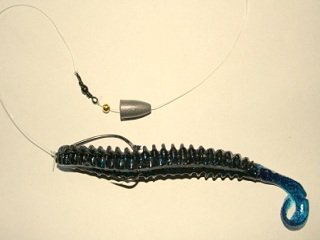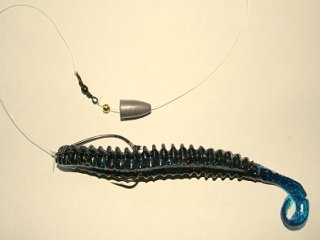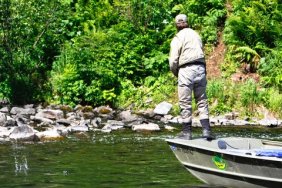 On the water, anglers are forced to change their approach on the fly when fish activity alters without rhyme or reason. There are certain times of the year—as well as certain times of the day—when certain presentations work better than others. When fish are more active and more aggressive with strikes, a quicker presentation, such as a buzzbait, will draw action. However, when fish slow down and become more reluctant to strike, anglers turn to one specific tactic: finesse. There are a few different finesse presentations from which to choose in such situations, but one of the most popular is the Carolina rig.
On the water, anglers are forced to change their approach on the fly when fish activity alters without rhyme or reason. There are certain times of the year—as well as certain times of the day—when certain presentations work better than others. When fish are more active and more aggressive with strikes, a quicker presentation, such as a buzzbait, will draw action. However, when fish slow down and become more reluctant to strike, anglers turn to one specific tactic: finesse. There are a few different finesse presentations from which to choose in such situations, but one of the most popular is the Carolina rig.
Carolina rigs are a great finesse tactic because, like the Texas rig, they get the bait down to the bottom and offer a more passive display. However, where they differ from Texas rigs is that they separate the bait from the sinker, which allows the bait to fall slowly. This is effective when fish are less prone to strike and take a few extra moments to consider the bait while it hovers in the strike zone.
To set up a Carolina rig, you’ll first need to slip a sinker onto the end of your line. Following the sinker is a bead, which will come in handy as a cushion between the sinker and the swivel, which is the next link in the chain. A barrel swivel works best and will, in many cases, create a clicking sound when it comes into contact with the bead. Next, you’ll need to tie on a decent length of fluorocarbon leader. The invisibility of fluorocarbon will help keep the rig from spooking wary fish. Finally, choose a soft plastic bait—worm, lizard, etc—and rig it weedless with a worm hook.
Tackle-wise, you’ll want to make sure you’re equipped with the optimal gear for a Carolina rig. Either a casting or spinning reel will work just fine, but for a rod, you’ll want to use nothing less than a medium-action, but I’d try to go with one that has a softer tip. Also, the type of sinker you use will vary depending upon the bottom. Weedy bottoms will require a cone-shaped weight, whereas rocky and sandy bottoms will require a walking and egg sinker, respectively. Whichever one you go with, be sure to use just enough weight to get to the bottom quickly.
After casting the Carolina rig, allow the sinker to reach bottom. The bait will fall slowly and if a fish should strike, you’ll feel a twitch. After around ten seconds without a hit, raise the rod tip a foot or so and then let it drop. This will pop the weight off the bottom, lifting the plastic, and then allows it to slowly waft back down, wavering for a moment in the strike zone. When a fish strikes, reel down and then set the hook steadily, but firmly. Remember, the bait is rigged weedless, so you’ll need a good motion to set the hook.
The Carolina rig is a very simple, but greatly effective, presentation for when the bass slow down. Feel free to experiment with different bait styles, lengths, and color patterns, as you see fit. I’ve had great success with worms in the 10-12 inch range, but also land a lot more fish in a morning with a smaller worm. Finesse fishing will test your patience, but the rewards from a diligent angler’s willingness to slowly pick apart a body of water greatly outweigh any perceived boredom from skeptics.








